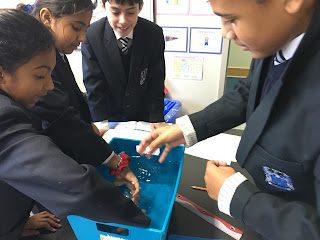I hope everyone is having a great week.
A quick message from the library…
A few quick reminders:
· Tomorrow is a Day 5.
· The hot lunch site is now open for November! The special this month is chicken stir fry, which is available every Friday. Please DO NOT order lunch for Thursday, November 21st as we are going on a field trip that day! The lunch site will close October 30th at 3:00 p.m. and payments will be due by November 6th.
· Aftercare invoices for the month of September have come out and were due Tuesday, October 15th, 2019. Any questions can be directed to Ms. Chiappetta at echiappetta@stjudesacademy.com
· Casual day forms were sent home and should be sent back signed with $20 for anyone participating. These are due by Friday, October 25th, 2019.
· Field Trip permission forms were sent home for our trip to the Canadian Warplane Heritage Museum on November 21st. These forms are due next Monday, October 21st and the cost is $27.
Inquiry into Air – We started the day with an inquiry into the properties of air. Yesterday, we did a series of experiments meant to help us examine these properties. The first thing we did is take up our experiments from yesterday to see what we were learning about air. From these experiments, we learned three things: air has mass, air takes up space, and air exerts pressure. After we did this, we continued by discussing the scientific method. We looked at the acronym ‘PHEOCA’.
· P – Purpose (or question)
· H – Hypothesis (educated guess)
· E – Experiment (procedures used)
· O – Observation (what you noticed)
· C – Conclusion (is your hypothesis correct)
· A – Application (where do you or could you see examples of what you learned)
Experiments are used to search for cause and effect. Variables are things that can change during an experiment; this can vary during an experiment. An independent variable is one that is changed by the scientist. A dependent variable are the variables the scientist observes to see how they respond to the change made to the independent variable. Controlled variables are quantities that a scientist keeps constant.
A fair test has been conducted when one factor (variable) is being changed at a time while all others are kept the same. A fair comparison can only be made once variables are being controlled and only one is changing at a time.
After this, we conducted more experiments to learn more about the properties of air, which we will be taking up tomorrow.
Science Fair – After this, students worked on their cars. With science fair only a few weeks away, we have entered a crunch time. A few students have their cars moving now!
Inquiry into Language – After lunch, we sat in our literature circle groups and had a discussion about chapter eighteen. We’re almost through the whole book! A reminder of the roles:
1. The discussion director comes up with insightful questions that will fuel discussion in the group.
2. The literary luminary chooses important passages for the group to read and discuss.
3. The connector makes connections between their own lives and the book (i.e. movies, other books they’ve read, real events, the current UOI, etc.)
4. The illustrator/mapper creates an illustration (i.e. comic, picture, mind map, etc.) based on what they felt during the chapter for the group to discuss.
5. The word wizard chooses 3 words that were interesting or new for everyone to discuss as a group.
Gym – After this, the students had gym with Mr. Orr, which you can read about on his blog (http://tysonorr.blogspot.com).
Inquiry into Math – Once gym was finished, the students wrote their pre-assessment for our next math unit, Geometry and Measurement.
After the pre-assessment, we started looking at what we will be covering in the unit. We first took a look at a few basic definitions, which included: polyhedron, prism, pyramid, regular polyhedron, vertex (vertices), faces, and edges. We already know two types of regular polyhedron (cube & tetrahedron [formerly triangular based pyramid]).
After this, we learned how to use isometric dot paper to draw 3D shapes on paper.
Finally, we examined a 3D object and drew examinations from the top, bottom, sides, front, and back.
Homework:
We do our best to complete work in class. In the event this is not possible, it will go home for homework.
As always, please feel free to email me with any questions.
Mr. Conte








































